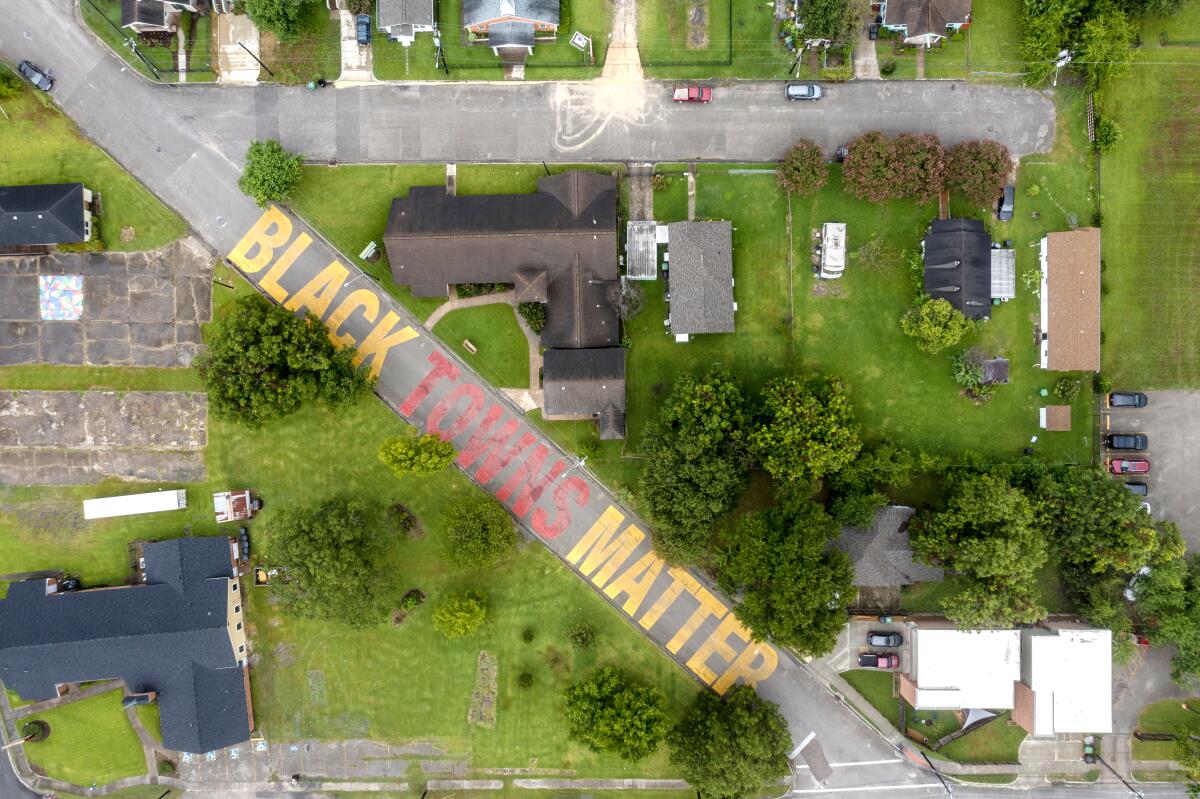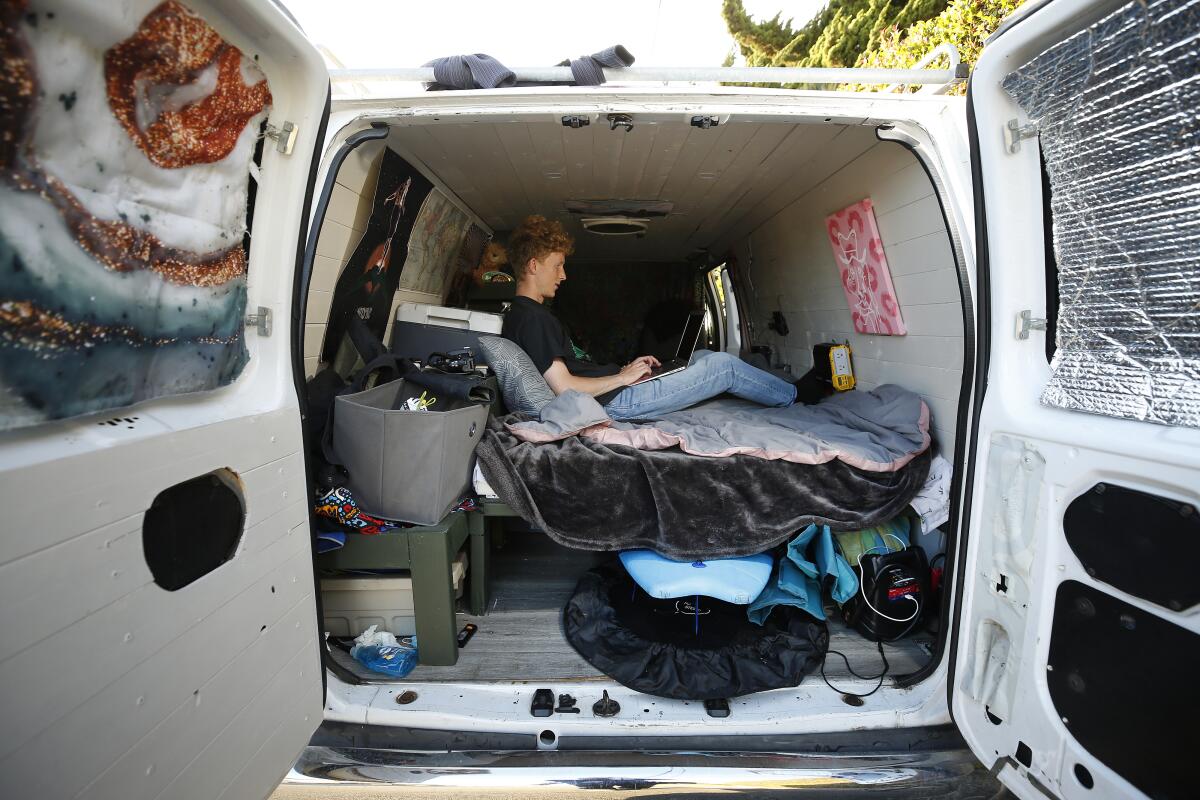The human toll of freeway expansion

- Share via
Good morning, and welcome to the Essential California newsletter. It’s Friday, Nov. 12. I’m Kiera Feldman filling in for Justin Ray.
America’s mid-20th century highway construction boom devastated Black communities, and now decades later freeway expansions and widenings are doing more of the same.
For the record:
8:21 a.m. Nov. 12, 2021A previous version of this newsletter incorrectly stated where nearly two-thirds of the displacements that The Times examined took place. The data refer to large projects affecting Black and Latino neighborhoods in California, North Carolina, Texas, Florida and Mississippi, not national displacements.
A new, must-read investigation by Liam Dillon and Ben Poston finds that in the last 30 years, 200,000 people were forced out of their homes for freeway construction. The actual total is higher because many states fail to report how many homes are taken annually.
No government agency collects demographic data on the people forced from their homes. So Times reporters requested reports and maps on the largest projects from states that have displaced the most families since 1991: California, North Carolina, Texas, Florida and Mississippi. From that data, Dillon and Poston found that nearly two-thirds of displacements occurred in projects disproportionately affecting Black and Latino neighborhoods.
[Read the investigation: “Freeways force out residents in communities of color — again” in the Los Angeles Times]
But more lanes on the highway means less traffic, right? Nope. Research shows that widening freeways doesn’t actually reduce congestion.
In the country’s 100 largest urban areas, highway planners added 30,000 miles of freeway lanes between 1993 and 2017, according to Transportation for America, a nonprofit advocacy group.
Experts have found that widening freeways can actually increase traffic, because it leads to housing development and encourages more vehicle trips.
Within five years after Texas transportation officials turned Interstate 10 in suburban Houston into one of the nation’s widest, traffic speeds during daily commutes were back to where they were before. An Interstate 405 widening through L.A.’s Sepulveda Pass seven years ago, which required a multiday closure dubbed “Carmageddon,” left rush-hour traffic just as tied up within a year of completion.
America’s interstate highway boom has a deeply racist history. When President Eisenhower created the U.S. Interstate Highway System in 1956, transportation planners used freeways to carve up Black communities. Within the first two decades of highway construction alone, more than 1 million people were forced from their homes, many of them in Black neighborhoods.
The highway program worked in concert with contemporary urban renewal efforts, building new developments that brought in suburban residents who were almost entirely white. Discriminatory real estate practices and low-interest loans made available only to white residents kept people of color out. Highway builders often defended taking property in Black neighborhoods by arguing the land was cheapest there — a fact that relied on government-backed mortgage redlining policies that discouraged investment in Black areas.
“Black neighborhoods were considered to be blight. They were considered to be slums,” Eric Avila, a history and Chicano studies professor at UCLA, told The Times. “The dominant perspective of the time was to eradicate blight, to get rid of slums. These neighborhoods were simply wiped out without any efforts to remediate the damage that was done.”
Many of those forced from their homes today for freeway expansion projects are the children and grandchildren of those who were displaced to build them. Some threatened by today’s freeway projects wonder why their families have been targeted once again.
When the 101 Freeway was built through Boyle Heights in Los Angeles in the 1950s, Alexandria Contreras’ great-grandparents were left with six roaring lanes a block away. Now, Contreras’ father fears the family’s two-bedroom stucco house in Downey could be at risk because of another planned widening of Interstate 5 in southeast L.A. County.
“When the first freeways were built in Boyle Heights, it was seen as an era of progress, but at what expense and at whose expense?” said Contreras, 27, who is of Mexican descent. “I’ve had too many generations suffer.”
And now, here’s what’s happening across California:
Note: Some of the sites we link to may limit the number of stories you can access without subscribing.
All adults in California can get COVID-19 booster shots. Top state health officials have announced that any adult who wants a booster should get one, and no one should be turned away. For Johnson & Johnson vaccine recipients, the booster needs to be at least two months after the jab. For those who got Pfizer-BioNTech or Moderna vaccines, the booster needs to be at least six months after the second dose. As concerns grow about the potential threat of a fifth wave of COVID-19, state health officials are encouraging all residents to get the booster. There is increasing evidence that the immunity provided by shots received months ago weakens over time. Without a booster, vaccinated people will be at greater risk for breakthrough infections, which can lead to hospitalizations and death among the most vulnerable. According to the CDC, only about 34% of fully vaccinated seniors in California 65 and older have received a booster shot; among all fully vaccinated adults in the state, only 14% have received one. Los Angeles Times
California college students live in vans and hotels as campus housing plans spark backlash. California’s student-housing crisis has forced hundreds of UC students to live in hotel rooms and vehicles. Recent news about UC Santa Barbara’s plans to build a 4,500-bed mega-dorm with tiny rooms and few windows — derisively dubbed “Dormzilla” — sparked outrage and national headlines. But the more urgent problem is a campus affordable housing crisis hitting thousands of students across California’s three public university systems — leaving some unsheltered, others with mounting debt burdens and many filled with anxiety and stress, reports Teresa Watanabe. More than 16,000 students at the University of California and California State University were on waitlists for housing this fall, despite construction of 36,000 beds by both systems since 2015, according to a new report. UC Berkeley alone turned away more than 5,500 housing requests this fall, and 40% of undergraduates are unable to live in the city due to scarce supply and high rents, the campus reports. Los Angeles Times

L.A. STORIES
Port congestion might be to blame for hazy skies and poor air quality in L.A. Over the first weekend of November, a thick mystery fog blanked the L.A. Basin. Some clean air advocates are blaming the long line of idling cargo ships anchored off the coast of Southern California. Air quality regulators say the poor visibility was due to seasonal weather effects that trap air pollution over the region but told reporter Nathan Solis that they would look into whether shipping was a factor. Ships outside the Port of Los Angeles are now waiting up to 14 days on average to enter, according to port officials. Over 100 ships are anchored and idling, and emissions are on the rise. Anchored ship emissions went from just 1% of overall ship emissions before the pandemic to 42% of emissions in December 2020. Los Angeles Times
Our daily news podcast
If you’re a fan of this newsletter, you’ll love our daily podcast “The Times,” hosted every weekday by columnist Gustavo Arellano, along with reporters from across our newsroom. Go beyond the headlines. Download and listen on our App, subscribe on Apple Podcasts and follow on Spotify.
POLITICS AND GOVERNMENT
California’s redistricting commission has put out its first official maps. The citizen panel released preliminary congressional, state Senate and state Assembly districts for public comment. The new districts will go into effect for the 2022 election and will remain in place for the next decade. The panel says these are preliminary maps that need to be tweaked before the Dec. 27 court-ordered deadline. There will be at least four public input meetings starting Nov. 17 and 14 line-drawing sessions between Nov. 30 and Dec. 19. Some incumbents might be worried: House Republican leader Kevin McCarthy of Bakersfield argues that congressional Democrats who won by 16 percentage points or less in 2020 would be in competitive races in 2022. LAist
CRIME AND COURTS
Judge denies L.A. police union’s request to block vaccine mandate. A judge on Wednesday denied a request by the Los Angeles police union that he block the city’s COVID-19 vaccination mandate for police officers. Yet, California Superior Court Judge Mitchell L. Beckloff must still rule on a related request for a preliminary injunction, which would halt the mandate for officers while a lawsuit the union filed against the city over the rollout of the vaccine requirement goes forward. A court hearing on the injunction is scheduled for next month. Under the city’s mandate, all city employees including police officers are required to be fully vaccinated by Dec. 18 unless they are granted a medical or religious exemption, and agree in the run-up to the deadline to submit to regular coronavirus testing if they are unvaccinated. The union claimed “there is no imminent threat to public health and safety or workplace safety posed by permitting unvaccinated masked” police officers. More than 3,200 of about 12,150 LAPD personnel have fallen ill from COVID-19, and 11 have died. Los Angeles Times
Support our journalism
HEALTH AND THE ENVIRONMENT
As more L.A. County Black and Latino men get the COVID-19 vaccine, distrust lingers. Vaccination rates among Black men are improving, but the medical industry has not earned their trust. Looming large are concerns referencing the Tuskegee experiment, when treatment for syphilis was withheld from hundreds of Black men in Alabama. Public health workers fear Black and Latino men will continue waiting to get vaccinated until they almost die from COVID-19 or watch people they know die, reports Marissa Evans; men of color say this mistrust arises from their frustration that they only get public health officials’ attention in times of crisis. Los Angeles County in recent months has made significant progress in vaccination rates among Black and Latino males age 12 and older. But Black males continue to have the lowest vaccination rate in the county across race and gender. Just 39% in the 18-29 age group have had at least one dose of the vaccine; for Latino men the figure is 52%. Los Angeles Times
CALIFORNIA CULTURE
Wide receiver Odell Beckham Jr. agrees to deal with Rams. The Rams announced Thursday they have agreed to terms with wide receiver Odell Beckham Jr. Super Bowl LVI will be played in February at SoFi Stadium, and Rams owner Stan Kroenke and team executives are sparing no expense. Last week, the Rams traded for eight-time Pro Bowl linebacker Von Miller, who could make his debut Monday night against the San Francisco 49ers. Beckham, 29, was the 12th player chosen in the 2014 NFL draft, one pick ahead of Rams star defensive tackle Aaron Donald. Los Angeles Times
Britney Spears’ 13-year conservatorship could finally end with today’s hearing. After a momentous court ruling in late September, Britney Spears’ conservatorship could finally come to an end today. A judge in Los Angeles is considering a petition to terminate the 13-year legal arrangement. The petition was filed Sept. 7 by the legal team for Jamie Spears, the pop star’s father, with Britney Spears’ attorneys supporting and adding to that petition in a separate filing on Oct. 28. Britney Spears described her conservatorship as “abusive” at an explosive hearing back in June, saying, “I’m not happy. I’m so angry it’s insane, and I’m depressed. I cry every day.” She said Jamie Spears “loved the control he had over me” at times. “He loved it.” Los Angeles Times
Free online games
Get our free daily crossword puzzle, sudoku, word search and arcade games in our new game center at latimes.com/games.
CALIFORNIA ALMANAC
Los Angeles: 93 San Diego: 83 San Francisco: 64 San Jose: 69 Fresno: 72 Sacramento: 67
AND FINALLY
Today’s California memory is from Kathryn Scalise:
I have five sisters. One of my favorite memories is our trip to San Diego on the train. Going between the cars felt dangerous and exciting. My mom is an excellent seamstress and made us matching outfits for the trip. Passengers looked at us because you didn’t often see people in matching outfits outside of Disneyland. The train was a constant in our childhood. You could hear it from our house at night. The stillness was punctuated by the horn and it still transports me.
If you have a memory or story about the Golden State, share it with us. (Please keep your story to 100 words.)
Please let us know what we can do to make this newsletter more useful to you. Send comments to [email protected].
Sign up for Essential California
The most important California stories and recommendations in your inbox every morning.
You may occasionally receive promotional content from the Los Angeles Times.




